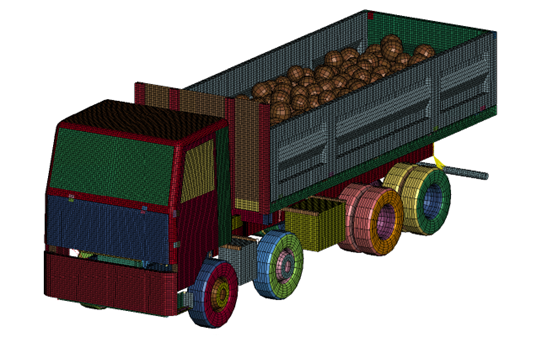Generic vehicle models for finite element numerical simulations

date: 17/02/2025
permalink: Main URL
In the framework of the research activity on the mitigation of consequences of vehicle ramming attacks for the protection of public spaces and critical infrastructure entities, the JRC has published a new generic vehicle model for the category N3G (30t) that includes bulk load.
The generic vehicles models can assist the development of vehicle security barriers and the assessment of their performance, as a complement to the physical testing required by the certification process (see ISO 22343-1:2023 standard).
This new JRC generic vehicle model of a 30t heavy-duty truck with bulk load (type N3G) complements the series of already existing models for types, N1, N2A and N3D. They support stakeholders to assess and analyse vehicle impacts on security barriers numerically. The vehicle models are brand independent and based on a set of parameters that allow an easy adaptation to any vehicle of the given category in terms of the vehicle mass, dimensions, crash related stiffness and suspension properties.
What was the motivation to choose this particular vehicle type category for model development?
Actually, previous stakeholder workshops of the working group for ‘Numerical simulation for hostile vehicle mitigation’ voiced a need for such a model, in particular as there are few models and experiments available for this category. ISO 22343 foresees three heavy-duty vehicles categories with bulk load, the categories N3E, N3F and N3G. Focusing more on European-type (cab over) vehicles for our stakeholders, complementing already existing models with a heavier type of vehicle with maximum mass and an increased number of axles, this left the N3G vehicle type category as the natural choice. In addition, this category has the highest ground clearance for the chassis, meaning it creates an impact on the security barrier at a higher point. All these factors contribute to a more challenging scenario configuration that can be simulated with this model.
What about the bulk load?
ISO 22343 specifies that bulk carrier vehicles, such as the N3G category, should be loaded with unsecured ballast to meet the test vehicle mass. In this model, unsecured ballast is modelled as rigid boulders (spherical shapes with variable sizes) through a ballast mass parameter that determines the amount of boulders and their density in correspondence with the dump box size of the vehicle. The advantage of using spherical rigid boulders instead of sand or soil is the fact that it is much more effective computation-wise, as sand and soil have more complex behaviour that may require specifically adapted particle methods (like SPH or DEM). This would complicate the simulation further and would have a negative impact on the easy convertibility of the model to other explicit solvers (not LS-DYNA). Furthermore, the availability of these particle methods in other codes cannot be guaranteed. The model allows simulating all types of loading conditions, from unloaded to full load. The maximum unsecured ballast foreseen in the model can be up to almost 20t, in line with ISO 22343.
What are particular advantages of generic vehicle models?
By using generic, simplified vehicle models, the focus of modelling efforts can shift primarily to the security barrier. In addition, this eliminates the need of developing own vehicle models or having to deal with constraints of proprietary-related issues.
The Generic Vehicle Models are available for download under the European Union Public Licence (EUPL) cost free. Find out more about our Generic Vehicle Models or go directly to the N3G Model page.
